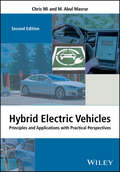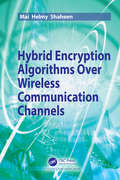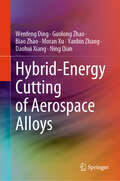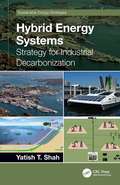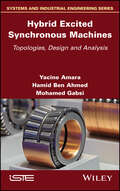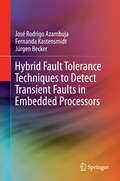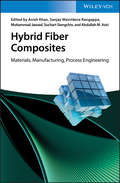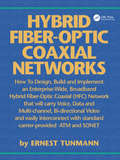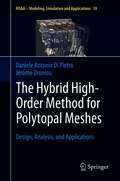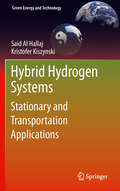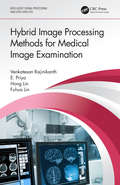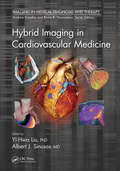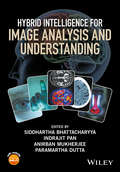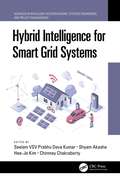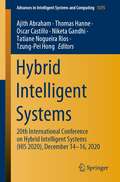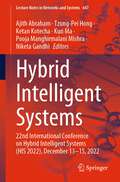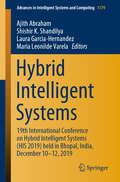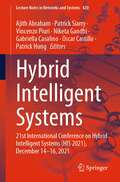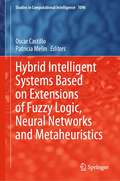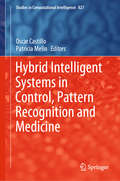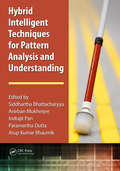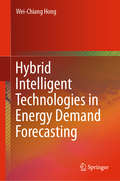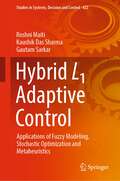- Table View
- List View
Hybrid Electric Vehicles: Principles and Applications with Practical Perspectives
by Chris Mi M. Abul MasrurThe latest developments in the field of hybrid electric vehicles Hybrid Electric Vehicles provides an introduction to hybrid vehicles, which include purely electric, hybrid electric, hybrid hydraulic, fuel cell vehicles, plug-in hybrid electric, and off-road hybrid vehicular systems. It focuses on the power and propulsion systems for these vehicles, including issues related to power and energy management. Other topics covered include hybrid vs. pure electric, HEV system architecture (including plug-in & charging control and hydraulic), off-road and other industrial utility vehicles, safety and EMC, storage technologies, vehicular power and energy management, diagnostics and prognostics, and electromechanical vibration issues. Hybrid Electric Vehicles, Second Edition is a comprehensively updated new edition with four new chapters covering recent advances in hybrid vehicle technology. New areas covered include battery modelling, charger design, and wireless charging. Substantial details have also been included on the architecture of hybrid excavators in the chapter related to special hybrid vehicles. Also included is a chapter providing an overview of hybrid vehicle technology, which offers a perspective on the current debate on sustainability and the environmental impact of hybrid and electric vehicle technology. Completely updated with new chapters Covers recent developments, breakthroughs, and technologies, including new drive topologies Explains HEV fundamentals and applications Offers a holistic perspective on vehicle electrification Hybrid Electric Vehicles: Principles and Applications with Practical Perspectives, Second Edition is a great resource for researchers and practitioners in the automotive industry, as well as for graduate students in automotive engineering.
Hybrid Encryption Algorithms over Wireless Communication Channels
by Mai Helmy ShaheenThis book presents novel hybrid encryption algorithms that possess many different characteristics. In particular, “Hybrid Encryption Algorithms over Wireless Communication Channels”, examines encrypted image and video data for the purpose of secure wireless communications. A study of two different families of encryption schemes are introduced: namely, permutation-based and diffusion-based schemes. The objective of the book is to help the reader selecting the best suited scheme for the transmission of encrypted images and videos over wireless communications channels, with the aid of encryption and decryption quality metrics. This is achieved by applying number-theory based encryption algorithms, such as chaotic theory with different modes of operations, the Advanced Encryption Standard (AES), and the RC6 in a pre-processing step in order to achieve the required permutation and diffusion. The Rubik’s cube is used afterwards in order to maximize the number of permutations. Transmission of images and videos is vital in today’s communications systems. Hence, an effective encryption and modulation schemes are a must. The author adopts Orthogonal Frequency Division Multiplexing (OFDM), as the multicarrier transmission choice for wideband communications. For completeness, the author addresses the sensitivity of the encrypted data to the wireless channel impairments, and the effect of channel equalization on the received images and videos quality. Complete simulation experiments with MATLAB® codes are included. The book will help the reader obtain the required understanding for selecting the suitable encryption method that best fulfills the application requirements.
Hybrid-Energy Cutting of Aerospace Alloys
by Guolong Zhao Wenfeng Ding Biao Zhao Ning Qian Moran Xu Yanbin Zhang Daohui XiangThis book pioneers the exploration of hybrid-energy cutting for aerospace alloys, summarizing cutting-edge research on laser-assisted, ultrasonic vibration-assisted, electrical-assisted, and hybrid-energies-assisted cutting. It also covers enhanced heat transfer in cutting processes, proposing novel technologies for achieving geometric precision and surface integrity at low costs. The book delves into multi-energy fields interaction mechanisms, material removal, tool wear, and cutting performance of aerospace alloys, alongside green and high-efficient cooling technologies. Targeting researchers, scientists, engineers, and professionals in aerospace, materials science, mechanical engineering, and manufacturing, this advanced-level resource assumes a solid background in engineering and materials science. It provides detailed discussions on theoretical aspects and practical applications of hybrid-energy cutting techniques. This book is a valuable reference for advanced researchers and practitioners in aerospace alloys cutting. It provides a comprehensive exploration of hybrid-energy technologies, detailed insights into mechanisms and performance, and a focus on sustainable and cost-effective cutting solutions.
Hybrid Energy Systems: Strategy for Industrial Decarbonization (Sustainable Energy Strategies)
by Yatish T. ShahHybrid Energy Systems: Strategy for Industrial Decarbonization demonstrates how hybrid energy and processes can decarbonize energy industry needs for power and heating and cooling. It describes the role of hybrid energy and processes in nine major industry sectors and discusses how hybrid energy can offer sustainable solutions in each. Introduces the basics and examples of hybrid energy systems Examines hybrid energy and processes in coal, oil and gas, nuclear, building, vehicle, manufacturing and industrial processes, computing and portable electronic, district heating and cooling, and water sectors Shows that hybrid processes can improve efficiency and that hybrid energy can effectively insert renewable fuels in the energy industry Serves as a companion text to the author’s book Hybrid Power: Generation, Storage, and Grids Written for advanced students, researchers, and industry professionals involved in energy-related processes and plants, this book offers latest research and practical strategies for application of the innovative field of hybrid energy.
Hybrid Excited Synchronous Machines: Topologies, Design and Analysis
by Hamid Ben Ahmed Yacine Amara Mohamed GabsiHybrid Excited Synchronous Machines: Topologies, Design and Analysis
Hybrid Fault Tolerance Techniques to Detect Transient Faults in Embedded Processors
by José Rodrigo Azambuja Fernanda Kastensmidt Jürgen BeckerThis book describes fault tolerance techniques based on software and hardware to create hybrid techniques. They are able to reduce overall performance degradation and increase error detection when associated with applications implemented in embedded processors. Coverage begins with an extensive discussion of the current state-of-the-art in fault tolerance techniques The authors then discuss the best trade-off between software-based and hardware-based techniques and introduce novel hybrid techniques. Proposed techniques increase existing fault detection rates up to 100%, while maintaining low performance overheads in area and application execution time.
Hybrid Fiber Composites: Materials, Manufacturing, Process Engineering (Engineering Materials Ser.)
by Mohammad Jawaid Anish Khan Suchart Siengchin Sanjay Mavinkere Rangappa AbdullahM. AsiriFiber-reinforced composites are exceptionally versatile materials whose properties can be tuned to exhibit a variety of favorable properties such as high tensile strength and resistance against wear or chemical and thermal influences. Consequently, these materials are widely used in various industrial fields such as the aircraft, marine, and automobile industry. After an overview of the general structures and properties of hybrid fiber composites, the book focuses on the manufacturing and processing of these materials and their mechanical performance, including the elucidation of failure mechanisms. A comprehensive chapter on the modeling of hybrid fiber composites from micromechanical properties to macro-scale material behavior is followed by a review of applications of these materials in structural engineering, packaging, and the automotive and aerospace industries.
Hybrid Fiber-Optic Coaxial Networks: How to Design, Build, and Implement an Enterprise-Wide Broadband HFC Network
by Ernest TunmannThis book covers the planning, design and implementation of hybrid fiber-optic coaxial (HFC) broadband networks in schools, universities, hospitals, factories and offices, whether they are in a single building or multiple campuses. Within the next few yea
The Hybrid Governance of Urban Food Movements: Learning from Toronto and Brussels (Urban Agriculture)
by Alessandra ManganelliUndertaking a journey into the “hybrid governance” of urban food movements, this book offers an original and nuanced analysis of the urban milieu as epicentre of food activism and food governance. Through examples of food movements in the city-regions of Toronto and Brussels, the author highlights the critical governance tensions urban food initiatives experience as they develop in diverse ways and seek to change food systems and their related socio-political conditions. The author investigates urban food movements as they negotiate access to land in urban areas, build resilient food network organisations, and develop supportive policies and empowering institutions for urban food governance. Through the analysis of these tensions, the book effectively puts real-life challenges of urban food movements in the spotlight—challenges that are increasingly visible and pertinent in today’s converging climate, socio-political, and health crises. The author offers suggestions to improve alternative food practices and, ultimately, to design promising pathways to instigate food system change.
The Hybrid High-Order Method for Polytopal Meshes: Design, Analysis, and Applications (MS&A #19)
by Jérôme Droniou Daniele Antonio Di PietroThis monograph provides an introduction to the design and analysis of Hybrid High-Order methods for diffusive problems, along with a panel of applications to advanced models in computational mechanics. Hybrid High-Order methods are new-generation numerical methods for partial differential equations with features that set them apart from traditional ones. These include: the support of polytopal meshes, including non-star-shaped elements and hanging nodes; the possibility of having arbitrary approximation orders in any space dimension; an enhanced compliance with the physics; and a reduced computational cost thanks to compact stencil and static condensation. The first part of the monograph lays the foundations of the method, considering linear scalar second-order models, including scalar diffusion – possibly heterogeneous and anisotropic – and diffusion-advection-reaction. The second part addresses applications to more complex models from the engineering sciences: non-linear Leray-Lions problems, elasticity, and incompressible fluid flows. This book is primarily intended for graduate students and researchers in applied mathematics and numerical analysis, who will find here valuable analysis tools of general scope.
Hybrid Hydrogen Systems
by Said Al-Hallaj Kristofer KiszynskiHybrid Hydrogen Systems for Stationary and Transportation Applications presents an original, comprehensive approach to hybrid energy system optimization and provides a much-needed systems approach to hydrogen energy applications. This textbook will be bought by graduate and senior undergraduate students studying renewable energy and the design and optimisation of hydrogen energy systems as well as the lecturers who teach these subjects. Hybrid Hydrogen Systems for Stationary and Transportation Applications will also be bought by researchers and practitioners working with hydrogen and fuel cells as well as policy makers and advocates of renewable energy.
Hybrid Image Processing Methods for Medical Image Examination (Intelligent Signal Processing and Data Analysis)
by Venkatesan Rajinikanth E Priya Hong Lin Fuhua LinIn view of better results expected from examination of medical datasets (images) with hybrid (integration of thresholding and segmentation) image processing methods, this work focuses on implementation of possible hybrid image examination techniques for medical images. It describes various image thresholding and segmentation methods which are essential for the development of such a hybrid processing tool. Further, this book presents the essential details, such as test image preparation, implementation of a chosen thresholding operation, evaluation of threshold image, and implementation of segmentation procedure and its evaluation, supported by pertinent case studies. Aimed at researchers/graduate students in the medical image processing domain, image processing, and computer engineering, this book: Provides broad background on various image thresholding and segmentation techniques Discusses information on various assessment metrics and the confusion matrix Proposes integration of the thresholding technique with the bio-inspired algorithms Explores case studies including MRI, CT, dermoscopy, and ultrasound images Includes separate chapters on machine learning and deep learning for medical image processing
Hybrid Imaging in Cardiovascular Medicine (Imaging in Medical Diagnosis and Therapy)
by Yi-Hwa Liu Albert J. SinusasThis comprehensive book focuses on multimodality imaging technology, including overviews of the instruments and methods followed by practical case studies that highlight use in the detection and treatment of cardiovascular diseases. Chapters cover PET-CT, SPECT-CT, SPECT-MRI, PET-MRI, PET-optical imaging, SPECT-optical imaging, photoacoustic Imaging, and hybrid intravascular imaging. It also addresses the important issues of multimodality imaging probes and image quantification. <P><P>Readers from radiology and cardiology as well as medical imaging and biomedical engineering will learn essentials of the field. They will be shown how the field has advanced quantitative analysis of molecularly targeted imaging through improvements in the reliability and reproducibility of imaging data. Moreover, they will be presented with quantification algorithms and case illustrations, including coverage of such topics such as multimodality image fusion and kinetic modeling. <P><P>Yi-Hwa Liu, PhD is Senior Research Scientist in Cardiovascular Medicine at Yale University School of Medicine and Technical Director of Nuclear Cardiology at Yale New Haven Hospital. He is also an Associate Professor (Adjunct) of Biomedical Imaging and Radiological Sciences at National Yang-Ming University, Taipei, Taiwan, and Professor (Adjunct) of Biomedical Engineering at Chung Yuan Christian University, Taoyuan, Taiwan. He is an elected senior member of Institute of Electrical and Electronic Engineers (IEEE) and a full member of Sigma Xi of The Scientific Research Society of North America. <P><P>Albert J. Sinusas, M.D., FACC, FAHA is Professor of Medicine (Section of Cardiovascular Medicine) and Radiology and Biomedical Imaging, at Yale University School of Medicine, and Director of the Yale Translational Research Imaging Center (Y-TRIC), and Director of Advanced Cardiovascular Imaging at Yale New Haven Hospital. He is a recipient of the Society of Nuclear Medicine’s Hermann Blumgart Award.
Hybrid Intelligence: Proceedings of the 4th International Conference on Computational Design and Robotic Fabrication (CDRF 2022) (Computational Design and Robotic Fabrication)
by Philip F. Yuan Hua Chai Chao Yan Keke Li Tongyue SunThis open access book is a compilation of selected papers from DigitalFUTURES 2022—The 4th International Conference on Computational Design and Robotic Fabrication (CDRF 2022). The work focuses on novel techniques for computational design and robotic fabrication. The contents make valuable contributions to academic researchers, designers, and engineers in the industry. As well, readers encounter new ideas about intelligence in architecture.
Hybrid Intelligence for Image Analysis and Understanding
by Anirban Mukherjee Indrajit Pan Paramartha Dutta Siddhartha BhattacharyyaA synergy of techniques on hybrid intelligence for real-life image analysis Hybrid Intelligence for Image Analysis and Understanding brings together research on the latest results and progress in the development of hybrid intelligent techniques for faithful image analysis and understanding. As such, the focus is on the methods of computational intelligence, with an emphasis on hybrid intelligent methods applied to image analysis and understanding. The book offers a diverse range of hybrid intelligence techniques under the umbrellas of image thresholding, image segmentation, image analysis and video analysis. Key features: Provides in-depth analysis of hybrid intelligent paradigms. Divided into self-contained chapters. Provides ample case studies, illustrations and photographs of real-life examples to illustrate findings and applications of different hybrid intelligent paradigms. Offers new solutions to recent problems in computer science, specifically in the application of hybrid intelligent techniques for image analysis and understanding, using well-known contemporary algorithms. The book is essential reading for lecturers, researchers and graduate students in electrical engineering and computer science.
Hybrid Intelligence for Smart Grid Systems (Advances in Intelligent Decision-Making, Systems Engineering, and Project Management)
by Seelam VSV Prabhu Deva KumarThis book provides an overview of distributed control and distributed optimization theory, followed by specific details on industrial applications to smart grid systems. It discusses the fundamental analysis and design schemes for developing actual working smart grids and covers all aspects concerning the conventional and nonconventional methods of their use. Hybrid Intelligence for Smart Grid Systems provides an overview of a smart grid, along with its needs, benefits, challenges, and existing structure and describes the inverter topologies adopted for integrating renewable power, and provides an overview of its needs, benefits, challenges, and possible future technologies. This pioneering book is a must-read for researchers, engineering professionals, and students, giving them the tools needed to move from the concept of a smart grid to its actual design and implementation. Moreover, it will enable regulators, policymakers, and energy executives to understand the future of energy delivery systems towards safe, economical, high-quality power delivery in a dynamic and demanding environment.
Hybrid Intelligent Systems: 20th International Conference on Hybrid Intelligent Systems (HIS 2020), December 14-16, 2020 (Advances in Intelligent Systems and Computing #1375)
by Ajith Abraham Thomas Hanne Oscar Castillo Niketa Gandhi Tatiane Nogueira Rios Tzung-Pei HongThis book highlights the recent research on hybrid intelligent systems and their various practical applications. It presents 58 selected papers from the 20th International Conference on Hybrid Intelligent Systems (HIS 2020) and 20 papers from the 12th World Congress on Nature and Biologically Inspired Computing (NaBIC 2020), which was held online, from December 14 to 16, 2020. A premier conference in the field of artificial intelligence, HIS - NaBIC 2020 brought together researchers, engineers and practitioners whose work involves intelligent systems, network security and their applications in industry. Including contributions by authors from 25 countries, the book offers a valuable reference guide for all researchers, students and practitioners in the fields of science and engineering.
Hybrid Intelligent Systems: 22nd International Conference on Hybrid Intelligent Systems (HIS 2022), December 13–15, 2022 (Lecture Notes in Networks and Systems #647)
by Ajith Abraham Tzung-Pei Hong Ketan Kotecha Kun Ma Pooja Manghirmalani Mishra Niketa GandhiThis book highlights the recent research on hybrid intelligent systems and their various practical applications. It presents 97 selected papers from the 22nd International Conference on Hybrid Intelligent Systems (HIS 2022) and 26 papers from the 18th International Conference on Information Assurance and Security, which was held online, from 13 to 15 December 2022. A premier conference in the field of artificial intelligence and machine learning applications, HIS–IAS 2022, brought together researchers, engineers and practitioners whose work involves intelligent systems, network security and their applications in industry. Including contributions by authors from over 35 countries, the book offers a valuable reference guide for all researchers, students and practitioners in the fields of Computer Science and Engineering.
Hybrid Intelligent Systems: 19th International Conference on Hybrid Intelligent Systems (HIS 2019) held in Bhopal, India, December 10-12, 2019 (Advances in Intelligent Systems and Computing #1179)
by Ajith Abraham Shishir K. Shandilya Laura Garcia-Hernandez Maria Leonilde VarelaThis book highlights the recent research on hybrid intelligent systems and their various practical applications. It presents 34 selected papers from the 18th International Conference on Hybrid Intelligent Systems (HIS 2019) and 9 papers from the 15th International Conference on Information Assurance and Security (IAS 2019), which was held at VIT Bhopal University, India, from December 10 to 12, 2019. A premier conference in the field of artificial intelligence, HIS - IAS 2019 brought together researchers, engineers and practitioners whose work involves intelligent systems, network security and their applications in industry. Including contributions by authors from 20 countries, the book offers a valuable reference guide for all researchers, students and practitioners in the fields of Computer Science and Engineering.
Hybrid Intelligent Systems: 21st International Conference on Hybrid Intelligent Systems (HIS 2021), December 14–16, 2021 (Lecture Notes in Networks and Systems #420)
by Ajith Abraham Patrick Siarry Vincenzo Piuri Niketa Gandhi Gabriella Casalino Oscar Castillo Patrick HungThis book highlights the recent research on hybrid intelligent systems and their various practical applications. It presents 45 selected papers from the 20th International Conference on Hybrid Intelligent Systems (HIS 2021) and 16 papers from the 17th International Conference on Information Assurance and Security, which was held online, from December 14 to 16, 2021. A premier conference in the field of artificial intelligence and machine learning applications, HIS-IAS 2021 brought together researchers, engineers and practitioners whose work involves intelligent systems, network security and their applications in industry. Including contributions by authors from over 20 countries, the book offers a valuable reference guide for all researchers, students and practitioners in the fields of computer science and engineering.
Hybrid Intelligent Systems Based on Extensions of Fuzzy Logic, Neural Networks and Metaheuristics (Studies in Computational Intelligence #1096)
by Oscar Castillo Patricia MelinIn this book, recent theoretical developments on fuzzy logic, neural networks and optimization algorithms, as well as their hybrid combinations, are presented. In addition, the above-mentioned methods are presented in application areas such as, intelligent control and robotics, pattern recognition, medical diagnosis, decision-making, time series prediction and optimization of complex problems. The book contains a collection of papers focused on hybrid intelligent systems based on soft computing techniques. There are a group of papers with the main theme of type-1 and type-2 fuzzy logic, which basically consists of papers that propose new concepts and algorithms based on type-1 and type-2 fuzzy logic and their applications. There also a group of papers that offer theoretical concepts and applications of meta-heuristics in different areas. Another group of papers outlines diverse applications of fuzzy logic, neural networks and hybrid intelligent systems in medical problems. There are also some papers that present theory and practice of neural networks in different application areas. In addition, there are papers that offer theory and practice of optimization and evolutionary algorithms in different application areas. Finally, there are a group of papers describing applications of fuzzy logic, neural networks and meta-heuristics in pattern recognition and classification problems.
Hybrid Intelligent Systems in Control, Pattern Recognition and Medicine (Studies in Computational Intelligence #827)
by Oscar Castillo Patricia MelinThis book describes the latest advances in fuzzy logic, neural networks and optimization algorithms, as well as their hybrid combinations, and their applications in areas such as: intelligent control and robotics, pattern recognition, medical diagnosis, time series prediction, and optimization of complex problems. The book is divided into five main parts. The first part proposes new concepts and algorithms based on type-1 and type-2 fuzzy logic and their applications; the second explores new concepts and algorithms in neural networks and fuzzy logic applied to recognition. The third part examines the theory and practice of meta-heuristics in various areas of application, while the fourth highlights diverse applications of fuzzy logic, neural networks and hybrid intelligent systems in medical contexts. Finally, the fifth part focuses on applications of fuzzy logic, neural networks and meta-heuristics to robotics problems.
Hybrid Intelligent Techniques for Pattern Analysis and Understanding
by Siddhartha Bhattacharyya Anirban Mukherjee Indrajit Pan Paramartha Dutta Arup Kumar BhaumikHybrid Intelligent Techniques for Pattern Analysis and Understanding outlines the latest research on the development and application of synergistic approaches to pattern analysis in real-world scenarios. An invaluable resource for lecturers, researchers, and graduates students in computer science and engineering, this book covers a diverse range of hybrid intelligent techniques, including image segmentation, character recognition, human behavioral analysis, hyperspectral data processing, and medical image analysis.
Hybrid Intelligent Technologies in Energy Demand Forecasting
by Wei-Chiang HongThis book is written for researchers and postgraduates who are interested in developing high-accurate energy demand forecasting models that outperform traditional models by hybridizing intelligent technologies. It covers meta-heuristic algorithms, chaotic mapping mechanism, quantum computing mechanism, recurrent mechanisms, phase space reconstruction, and recurrence plot theory. The book clearly illustrates how these intelligent technologies could be hybridized with those traditional forecasting models. This book provides many figures to deonstrate how these hybrid intelligent technologies are being applied to exceed the limitations of existing models.
Hybrid L1 Adaptive Control: Applications of Fuzzy Modeling, Stochastic Optimization and Metaheuristics (Studies in Systems, Decision and Control #422)
by Roshni Maiti Kaushik Das Sharma Gautam SarkarThis book details the designing of hybrid control strategies for practical systems containing time varying uncertainties, disturbances, nonlinearities, unknown parameters, unmodelled dynamics, delays, etc., concurrently. In this book, the advantages of different controllers will be brought together to produce superior control performance for the practical systems. Being aware of the advantages of adaptive controller to tackle unknown constant, time varying uncertainties and time varying disturbances, a variant of adaptive controller, namely L1 adaptive controller, is hybridized with other strategies. In this book, to facilitate optimal parameter setting of the basic L1 adaptive controller, stochastic optimization technique will be hybridized with it. The stability of the optimization technique along with the controller will be guaranteed analytically with the help of spectral radius convergence. The proposed method exhibits satisfactory exploration and exploitation capabilities. Again, this book will throw light on tackling nonlinearities along with uncertainties and disturbances by hybridizing fuzzy logic with L1 adaptive controller. The performances of the designed controllers will be compared with different control methodologies to validate their effectiveness. The overall stability of the nonlinear system with the designed controller will be guaranteed with the help of fuzzy Lyapunov function to retain the zonal behaviour of the system. This fuzzy PDC-L1 adaptive controller is efficient to tackle nonlinearities and at the same time cancels unknown constant, time varying uncertainties and time varying disturbances adequately. This book will also contain four simulation case studies to validate fruitfulness of the designed controllers. To demonstrate the superior control ability of these controllers in tackling practical system, three experimental case studies will also be provided.
